
Am Fam Physician. 2018;97(7):473
I am a 46-year-old woman with chronic pain. Even though I am still fairly young, I have developed many medical conditions. In 2002, I was diagnosed with fibromyalgia. This causes severe muscle pain in my neck, shoulders, and back. I am now on many medications, see several doctors and a physical therapist, and visit my family doctor regularly for trigger point injections.
I am a strong single mother, but chronic pain has changed my life in many ways. I used to be a very active person. I loved to hike and I worked as a nanny. Now I can no longer work, I only dream of taking long trips, and I wish I could play with my son again. What I hope for most is to just feel normal.
The chronic pain has also forced me to move back into my parents' house. I give most of my disability income to my parents who help support me. I am unable to save money; therefore, I don't make long-term plans. My mother always tells me, “When you are down, the only place you can look is up”, but it is hard to not feel frustrated and helpless sometimes.
At one point, I felt so hopeless that I tried to kill myself. Thankfully, I did not succeed. Soon after that, I underwent bypass surgery for my heart condition. I woke up from surgery feeling a desire to live. I have not felt such a strong craving for life in a long time.
So, what helps me push on? Here is my prescription for dealing with chronic pain:
Keep a positive attitude: don't take things for granted, and cherish the good moments in life.
Restructure your priorities: if you can't do the things you used to love, find new hobbies to enjoy.
Find meaning in your life— sources of hope, strength, comfort, and peace.
Find support groups: there are others who are going through the same thing, and you are not alone. –C.S.

Commentary
A critical part of providing high-quality, patient-centered care for those living with chronic pain is developing a good understanding of the many ways their lives are affected by their symptoms. Validating their concerns and feelings can strengthen the physician-patient relationship and serve as an important tool in helping these patients manage their illnesses.
Additional approaches include fostering shared decision making through ongoing education, setting realistic treatment goals focused on preserving and improving function, and incorporating multimodal treatment strategies including nonpharmacologic options.
In the end, more than simply being given the correct diagnoses and medications, patients like C.S. need our support, encouragement, and empathy to give them the best chance at a quality life.
